

Sustainable Development Goals. Guns, Germs and Steel - Diamond, Jared. Black death skeletons reveal pitiful life of 14th-century Londoners. Mapping the 1854 Cholera Outbreak. GIS analysis of Snow's London cholera map. GIS Analyses of Snow's Map Snow's map, demonstrating the spatial clustering of cholera deaths around the Broad Street well, provided strong evidence in support of his theory that cholera was a water-borne disease.

Snow used some proto-GIS methods to buttress his argument: first he drew Thiessen polygons around the wells, defining straight-line least-distance service areas for each. 1854 Broad Street cholera outbreak. Broadwick Street showing the John Snow memorial and public house.

Background[edit] In the mid-19th century, the Soho district of London had a serious problem with filth due to the large influx of people and a lack of proper sanitary services: the London sewer system had not reached Soho. Many cellars (basements) had cesspools of night soil underneath their floorboards. Since the cesspools were overrunning, the London government decided to dump the waste into the River Thames. This action contaminated the water supply, leading to a cholera outbreak. Outbreak[edit] Over the next three days, 127 people on or near Broad Street died. John Snow investigation[edit]
Air pollution in Victorian-era Britain – its effects on health now revealed. The health hazards of atmospheric pollution have become a major concern in Britain and around the world.
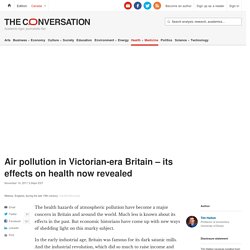
Much less is known about its effects in the past. But economic historians have come up with new ways of shedding light on this murky subject. In the early industrial age, Britain was famous for its dark satanic mills. And the industrial revolution, which did so much to raise income and wealth, depended almost entirely on one fuel source: coal. Coal supplied domestic hearths and coal-powered steam engines turned the wheels of industry and transport.
In Britain, emissions of black smoke were up to 50 times higher in the decades before the clean air acts than they are today. Unregulated coal burning darkened the skies in Britain’s industrial cities, and it was plain for all to see. Broad Street Pump Outbreak. The following description of the Broad Street Pump Outbreak was written by Judith Summers in her history of the Soho neighborhood of London.
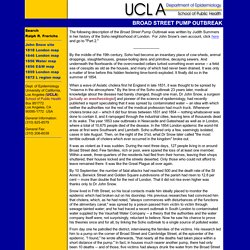
For John Snow's own account, click here and go to "Part 2. " By the middle of the 19th century, Soho had become an insanitary place of cow-sheds, animal droppings, slaughterhouses, grease-boiling dens and primitive, decaying sewers. Bill Gates has a utopian dream. Watch this guy grill him about it.
Bhopal Disaster. On the night of December 2, 1984 a pesticide plant in Bhopal, India leaked methyl isocynate gas and other chemicals creating a dense toxic cloud over the region and killing more than 8,000 people in just the first few days.

Take action right now to prevent a tragedy like Bhopal from ever happening again. Greenpeace is taking action On the twenty-fifth anniversary of the Bhopal disaster, a coalition of labor and environmental groups put out a call for safety at U.S. chemical plants. Just 300 of the 6,000+ high-risk chemical sites across the U.S. put more than 100 million Americans at risk if attacked. Home. Start of a Movement. History: Love Canal: the Start of a Movement By Lois Marie Gibbs Lois Marie Gibbs was the key leader of Love Canal residents in their fight to be relocated away from a toxic dump containing over 20,000 tons of chemicals.

She is the Executive Director of the Center for Health, Environment and Justice, which she founded in 1981 following the Love Canal struggle. CHEJ is a national organization that assists local people to become empowered to protect their communities from environmental threats. The following text was written by Lois Marie Gibbs and CHEJ in 1983 and updated in 1997 and 2002. The Love Canal Tragedy. By Eckardt C.
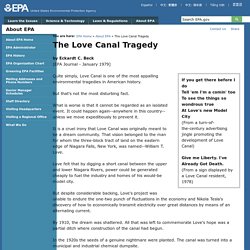
Beck [EPA Journal - January 1979] If you get there before I do Tell 'em I'm a comin' too To see the things so wondrous true At Love's new Model City (From a turn-of-the-century advertising jingle promoting the development of Love Canal) Give me Liberty. I've Already Got Death. The Life and Legacy of Rachel Carson. Smudge stick. A smudge stick is a bundle of dried herbs, usually bound with string into a small bundle.
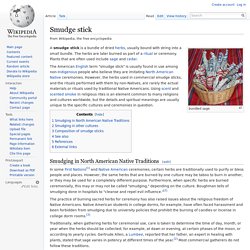
The herbs are later burned as part of a ritual or ceremony. Plants that are often used include sage and cedar. The American English term "smudge stick" is usually found in use among non-Indigenous people who believe they are imitating North American Native ceremonies. However, the herbs used in commercial smudge sticks, and the rituals performed with them by non-Natives, are rarely the actual materials or rituals used by traditional Native Americans.
Using scent and scented smoke in religious rites is an element common to many religions and cultures worldwide, but the details and spiritual meanings are usually unique to the specific cultures and ceremonies in question. Smudging in North American Native Traditions[edit] In some First Nations[1] and Native American ceremonies, certain herbs are traditionally used to purify or bless people and places. WORLD HEALTH RANKINGS. Access more than 36,000 Country Health correlations with this powerful comparison tool that let's you create side by side comparisons between any two countries in the world.

Simply select a country from the list below to visit that country's page, we have selected a default comparison for you. Use the scrolling lists menu to select which country you want to compare it to or choose a new country. The History of Sanitary Sewers. From smoke stacks to solar: Port Augusta. 20 December 2017 Port Augusta had long been South Australia’s coal-fired powerhouse.
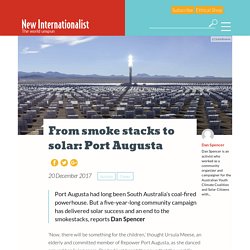
But a five-year-long community campaign has delivered solar success and an end to the smokestacks, reports Dan Spencer ‘Now, there will be something for the children,’ thought Ursula Meese, an elderly and committed member of Repower Port Augusta, as she danced around her living room. She had just heard the news that the world’s biggest solar thermal tower with storage had been given the green light, thanks to the Repower campaign. Ursula was one of many locals in Port Augusta who had spent over five years campaigning for the South Australian and Federal Government to reconsider its carbon footprint.
Now, with the two coal stations being demolished, and a new solar plant in their place, Port Augusta has a bright future ahead as a clean energy hub This didn’t just happen overnight, of course. When the local group formed, Lisa’s son Lachie was only a few months old. London Lives 1690 to 1800 ~ Crime, Poverty and Social Policy in the Metropolis. DisasterHistory.org. The History of Pandemics, by Death Toll. Pan·dem·ic /panˈdemik/ (of a disease) prevalent over a whole country or the world. As humans have spread across the world, so have infectious diseases. Even in this modern era, outbreaks are nearly constant, though not every outbreak reaches pandemic level as COVID-19 has.
Chernobyl Disaster in rare pictures, 1986 - Rare Historical Photos. Human impact has pushed Earth into the Anthropocene, scientists say. There is now compelling evidence to show that humanity’s impact on the Earth’s atmosphere, oceans and wildlife has pushed the world into a new geological epoch, according to a group of scientists. The question of whether humans’ combined environmental impact has tipped the planet into an “Anthropocene” – ending the current Holocene which began around 12,000 years ago – will be put to the geological body that formally approves such time divisions later this year. The new study provides one of the strongest cases yet that from the amount of concrete mankind uses in building to the amount of plastic rubbish dumped in the oceans, Earth has entered a new geological epoch.
“We could be looking here at a stepchange from one world to another that justifies being called an epoch,” said Dr Colin Waters, principal geologist at the British Geological Survey and an author on the study published in Science on Thursday. Global estimates of burden of disease caused by the environment and occupational risks. Aboriginal meditation is being used to heal minds in the modern world. Posted From the tiny community of Nauiyu, south of Darwin, Miriam Rose Baumann is preparing to meet her next group of interstate visitors. "It's not a tour where you have to pack your bags and get ready to jump on a bus that's going to be leaving at 6:00am in the morning, to take you to places and be there at certain times to do things," Ms Baumann said. "It's just chilling-out time and sometimes the non-Indigenous people who come here find that really, really stressful.
" Nauiyu, a town of less than 700 people, was once known primarily for having the best barramundi fishing in Australia, but these tourists are travelling from Geelong in Victoria for another reason.